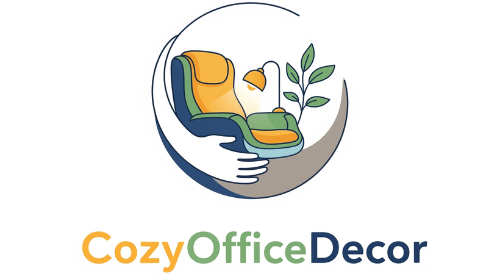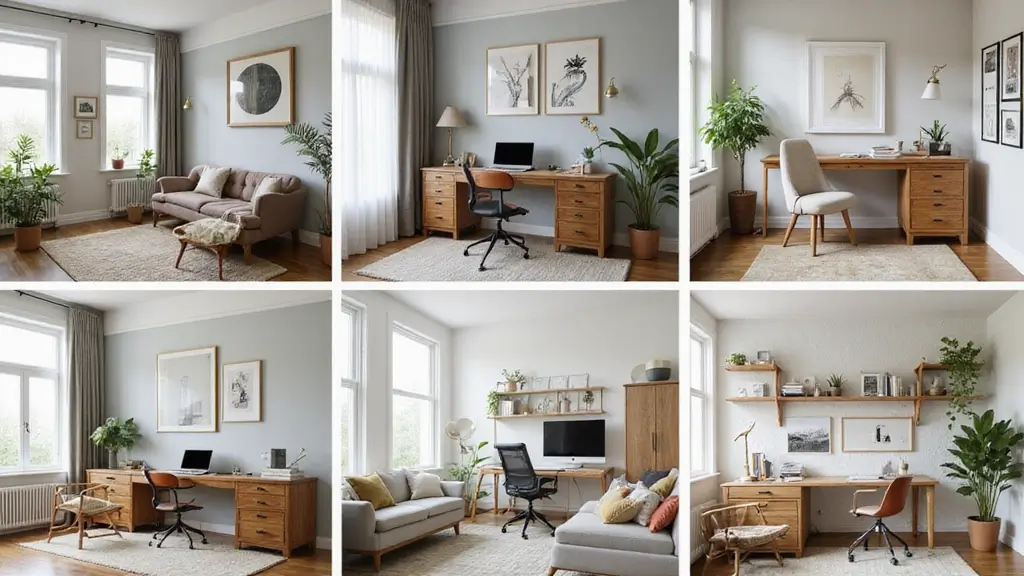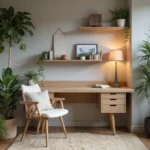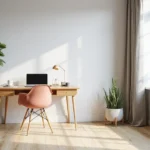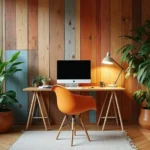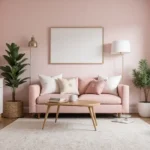Creating a home office that works well in a small space requires careful planning and creativity.
With remote work becoming the norm, having a dedicated workspace can significantly improve productivity and comfort.
From clever storage solutions to multifunctional furniture, these 29 home office layout ideas will inspire you to craft the perfect work environment, no matter how limited your space may be.
Let’s explore some amazing designs and tips that can make your home office not just functional but also a place where you love to work.
1. Corner Workspace

Utilizing corners can instantly maximize your small office space.
A corner workspace design often involves a compact desk that fits snugly into an L-shape. Consider adding shelves or pegboards above to keep your essentials within arm’s reach.
Benefits include:
– Efficient use of underutilized space
– Reduced distractions by creating a defined work zone
– Room for plants or art to enhance aesthetics
This layout encourages organization and helps maintain focus, making it ideal for those working from smaller homes.
2. Wall-Mounted Desk

Wall-mounted desks can be a game-changer for a minimalist office setup.
These desks free up floor space and often include storage solutions like floating shelves or wall organizers. Choose one that folds down when you need it and tucks away when you don’t.
Key considerations:
– Ensure it’s installed at the right height for ergonomic comfort
– Add a comfortable chair that can be moved easily
– Use vibrant wall colors or art to enhance the atmosphere
This layout makes your workspace feel less cluttered and more organized, which is key to productivity.
3. Multi-Functional Furniture

In small spaces, furniture needs to do double duty.
Look for desks that can transform into dining tables or bookshelves that can double as a desk. This approach saves space and adds functionality to your office.
Look for:
– Desks with integrated storage options
– Ottomans that can store office supplies
– Nesting tables that can be tucked away
Embracing multipurpose furniture helps maintain a streamlined look, making your home office both stylish and functional.
In small spaces, every piece of furniture should earn its keep! Choose multi-functional pieces to create a stylish home office that works as hard as you do.
4. Vertical Storage Solutions

When you’re short on space, thinking vertically is essential.
Utilizing vertical storage shelves or over-the-door organizers can turn cluttered areas into efficient workspaces. This keeps the floor clear and your desk clutter-free.
Strategies include:
– Installing shelves above your desk for easy access to books and supplies
– Using pegboards to hang tools and art supplies
– Adding tall bookcases to leverage height
Creating a vertical storage plan not only makes your office more organized but also adds an element of design to the room.
5. Natural Light Integration

Natural light can significantly enhance your workspace.
Position your desk near windows to capitalize on sunlight, which improves mood and productivity. Use sheer curtains to filter light while maintaining privacy.
Tips to enhance natural light:
– Use mirrors to reflect light around the room
– Choose light color palettes to brighten the space
– Incorporate plants that thrive in natural light
Creating a bright environment can energize your work routine and make you feel more connected to the outside world.
Let the sunshine in! Positioning your desk by a window can uplift your mood and boost productivity. Embrace natural light and watch your workspace transform!
6. Utilize Closet Space

Transforming a closet into a workspace is a smart way to maximize square footage.
This concept can take various forms — from a simple desk setup to fully outfitted office solutions with shelving and storage.
Consider these tips:
– Use sliding doors to save space when accessing your office
– Keep everything organized with bins or boxes
– Make it personal with décor elements that inspire you
A closet office allows you to close the door on work at the end of the day, creating a true separation between work and home life.
7. Standing Desks

Standing desks have gained popularity for their health benefits and space-saving design.
They encourage movement and can be adjusted for sitting or standing at ease. Incorporating one into your home office not only saves space but also promotes better posture.
Benefits include:
– Flexibility to switch between sitting and standing
– Improved focus and energy levels
– A modern aesthetic that elevates your workspace
Standing desks can enhance your workspace ergonomics while making it a visually appealing setup.
8. Color Psychology

The colors in your home office can greatly influence your mood and productivity.
Soft blues and greens can promote calmness, while yellows and oranges can energize the space. Choosing the right color palette can be a form of workspace organization that helps you feel your best while working.
Color tips:
– Use accent walls to create focal points
– Integrate colorful office supplies for a fun vibe
– Keep larger pieces neutral and let small items shine
Balancing colors thoughtfully can transform a workspace from mundane to motivating.
9. Cozy Nook Designs

Turning a small nook into a cozy work area can make your home office feel inviting.
Use what’s available, like a corner in a living room or even a stair landing, and decorate it with warm lighting and soft textiles.
Considerations for a cozy nook include:
– A comfortable chair that encourages relaxation
– Soft throw blankets or pillows for added comfort
– Decorative lights to create a warm ambiance
This intimate atmosphere can help foster creativity and comfort in your daily tasks.
A cozy nook can be your creativity haven! Transform any small space into a warm work corner with soft textiles and ambient lighting—perfect for making your home office feel inviting.
10. Minimalist Approach

Sometimes less is more, especially in a small office.
A minimalist design promotes simplicity and focus, limiting distractions and making your space feel cleaner.
Tips for achieving a minimalist look:
– Choose a simple, functional desk design
– Limit decor to a few meaningful items
– Keep surfaces as clear as possible
Embracing minimalism can clear your mind and enhance productivity, making it a desirable choice for many remote workers.
Embrace minimalism in your home office: a clear space leads to a clear mind. Less clutter means more focus, making every work hour count!
11. Tech-Friendly Layout

With technology at the core of many home businesses, creating a tech-friendly workspace is crucial.
Ensure that your setup can accommodate all devices seamlessly, with adequate charging stations and cable management systems.
Key elements to consider:
– Use cable organizers to keep things tidy
– Include power strips that are easily accessible
– Designate areas for printers and other tech tools
A tech-friendly office enhances efficiency, making it easier to access and use your tech solutions without clutter.
12. Artistic Inspiration

Incorporating art into your home office can inspire creativity and motivation.
From framed artwork to DIY projects, bringing art into your space can add personality and joy.
Ways to add art include:
– Creating a gallery wall of inspiring images
– Using art prints as mousepads or desk mats
– Commissioning local artists for unique pieces
Art can be a source of inspiration, making your workspace feel more personal and engaging.
13. Biophilic Design

Bringing the outside in with biophilic design enhances well-being and creativity.
Incorporating plants, natural materials, and earthy colors can create a calming atmosphere.
Tips to implement biophilic design:
– Use potted plants or hanging planters for greenery
– Choose wooden furniture to add warmth
– Use natural light to brighten the space
Biophilic design can transform your office into a restorative haven, improving both mood and productivity.
14. Personalized Workspaces

Your home office should reflect your personality and style.
Personal touches can create an environment that feels comfortable and motivating.
Examples of personalization:
– Adding family photos or personal artwork
– Using your favorite colors in decor
– Displaying awards or achievements as reminders of your journey
Personalizing your workspace makes it a delight to be in, helping to increase your work satisfaction.
15. Ergonomic Furniture

Investing in ergonomic furniture is crucial for health and productivity, especially in small spaces.
Ergonomic chairs and desks promote good posture, reducing strain during long hours of work.
Consider the following:
– Adjustable chairs to fit your height
– Desks at the correct height to prevent slouching
– Accessories like footrests or keyboard trays
Ergonomic furniture can significantly improve your work experience, keeping you comfortable and focused.
16. Open Shelving

Open shelving not only maximizes wall space but also adds a decorative element to your office.
You can showcase books, plants, and decorative items, turning your storage into a display area.
Benefits of open shelving include:
– Easy access to frequently used items
– A cleaner, more open feel than closed cabinets
– Flexibility to change displays as you wish
Open shelves invite creativity and can make your home office feel more vibrant.
17. Use of Mirrors

Mirrors can enhance the sense of space in a small office while reflecting light, making the area feel larger.
Strategically placing mirrors can open up your work environment and contribute to an inviting atmosphere.
Tips for mirror placement include:
– Position mirrors opposite windows to maximize light
– Use decorative mirrors as art pieces
– Ensure mirrors coordinate with your overall decor
Incorporating mirrors cleverly can enhance the look and feel of your workspace.
18. Quiet Zones

Creating a quiet zone in your home office can improve focus and reduce distractions.
This could mean utilizing soundproofing materials, or even just setting up a designated area with fewer visual distractions.
Ways to create a quiet zone include:
– Using rugs to absorb sound
– Adding partitions to block out noise
– Choosing soft colors and simple decor that doesn’t overwhelm
A quiet space enhances productivity and gives you a dedicated area to concentrate fully on your work.
19. Clutter-Free Desks

A clutter-free desk is essential for maintaining focus and efficiency.
Adopting a cleaning routine and prioritizing essential items can keep your workspace organized.
Keys to a decluttered desk include:
– Having a designated space for everything
– Limiting the number of items on your desk
– Regularly assessing what you truly need
A clean desk not only improves aesthetics but also enhances your ability to remain productive throughout the day.
20. Flexible Workstations

Flexible workstations allow for adaptability, catering to different tasks or moods.
A setup that can be easily altered encourages creativity and responsiveness to your workflow.
Examples include:
– Desks that can be rearranged for collaboration
– Seating that can switch between casual and formal
– Tech setups that can be adjusted for changing needs
Creating a flexible environment makes your office more dynamic and engaging.
21. Smart Lighting Solutions

Lighting plays a crucial role in any workspace, especially in small offices.
Smart lighting systems can provide adjustable brightness and colors that suit your tasks and mood.
Considerations for smart lighting include:
– Choosing daylight bulbs for energy and focus
– Integrating desk lamps with adjustable settings
– Utilizing dimmers for creating a cozy atmosphere
Good lighting can transform your work experience, making it more pleasant and productive.
22. Inspirational Quotes

Incorporating motivational quotes into your home office can provide daily inspiration.
Whether they are framed on the wall or printed on your desk items, they can uplift your spirits during busy workdays.
Ways to add quotes include:
– Wall decals that are removable
– Desk mats or mousepads with inspiring phrases
– Desk accessories that serve as reminders of your goals
These small elements can boost motivation and create a positive work environment.
23. Colorful Accessories

Adding colorful accessories can liven up your office space and make it feel more fun.
From bright stationery to colorful chair cushions, these elements can reflect your personality while keeping the vibe positive.
Ideas for colorful accessories include:
– Bright mouse pads and coasters
– Vibrant storage solutions that pop
– Cheerful artwork to adorn the walls
These accents can energize your workspace and create a more enjoyable environment.
24. Responsive Furniture

Responsive furniture adapts to your needs and is essential for a functional office.
Look for pieces that can be easily moved or reconfigured based on your activities for the day.
Benefits of responsive furniture:
– Easy transitions between tasks
– Customization based on personal preferences
– Versatility for collaborative work sessions
Responsive design helps create a comfortable and accommodating workspace.
25. Sound-Absorbing Elements

In small spaces, noise can be a significant distraction.
Sound-absorbing elements, such as wall panels or rugs, can help create a quieter workspace.
Consider these soundproofing options:
– Adding thick curtains to windows
– Using rugs to muffle noise
– Incorporating fabrics in your decor that absorb sound
These elements can calm the environment, making it easier to concentrate on tasks.
26. Seasonal Decor

Changing your office decor seasonally can keep the workspace feeling fresh and exciting.
Incorporate seasonal colors and themes into your workspace to reflect different times of the year.
Ideas for seasonal decor:
– Rotate desk plants and flowers based on the season
– Use themed wall art or decorations
– Incorporate seasonal colors in accessories
This can bring a lively touch to your office and evoke seasonal moods.
27. Create Zones

Dividing your workspace into different zones can help streamline productivity.
Whether it’s a reading nook, a tech station, or a creative area, designating spaces for specific tasks can improve focus.
Benefits of creating zones include:
– Clearer boundaries between tasks
– Enhanced organization
– Increased efficiency and productivity
Zoning out your workspace can help you stay on task and maintain a sense of order.
28. Use of Textiles

Textiles can add warmth and comfort to your home office, making it more inviting.
Incorporate fabrics through curtains, cushions, or rugs to create a cozy atmosphere.
Considerations for textiles include:
– Using soft fabrics for a comfortable chair
– Adding colorful rugs to define spaces
– Incorporating cushions or throws for warmth
Textiles can transform the energy of your office, making it more relaxed and enjoyable.
29. Personal Library Corner

Creating a personal library corner in your home office can provide a haven for inspiration and learning.
Incorporate bookshelves filled with your favorite reads, accompanied by a comfortable chair for those moments of escape.
Ideas for a library corner include:
– Cozy seating options like a beanbag or armchair
– Good lighting for reading
– Display shelves for showcasing book covers
This corner can double as a retreat when you need a break from your tasks.
Conclusion

Crafting a home office that reflects your style while maximizing space is essential for comfort and productivity.
The ideas explored here can help you create a workspace that works for you, no matter the constraints of your environment.
Don’t hesitate to mix and match these concepts to create your unique haven where you can thrive and feel inspired.
Frequently Asked Questions
What are the best home office layout ideas for small spaces?
When working with a small space, consider layouts like a corner workspace or a wall-mounted desk. These options maximize your area by utilizing corners and freeing up floor space.
Additionally, multi-functional furniture can make a big difference by serving more than one purpose, such as a desk that doubles as a dining table. Don’t forget about vertical storage solutions to keep clutter at bay!
How can I make my home office more ergonomic?
Investing in ergonomic furniture is crucial for comfort and productivity. Choose a chair that supports your back and a desk at the right height to reduce strain.
Consider incorporating a standing desk or a desk converter to alternate between sitting and standing. Remember, a well-structured workspace around your body can enhance your focus and overall work experience.
What tips can help improve productivity in a home office?
To boost productivity in your home office, start by creating designated zones for different tasks. This can help streamline your workflow.
Additionally, integrating natural light into your workspace can elevate your mood and energy levels. Keep your desk clutter-free and personalize your space with inspirational quotes or art to maintain motivation.
How can I utilize closet space for a home office?
Transforming a closet into a workspace is a fantastic way to maximize square footage! You can install a compact desk and add shelves or organizers for storage.
Consider using sliding doors to conceal your office when not in use, keeping your space tidy. This setup can be both functional and stylish, making it perfect for small living areas.
What color schemes are best for a home office to enhance focus?
The right color scheme can significantly impact your mood and productivity. Soft blues and greens create a calming atmosphere, while yellows and oranges can energize the space.
Consider painting an accent wall or using colorful accessories to reflect your personality while maintaining a focus-friendly environment. Experiment with different shades to find what inspires you the most!
Related Topics
home office layout
small spaces
workspace organization
ergonomic furniture
minimalist design
natural light
multi-functional furniture
productivity tips
tech-friendly workspace
biophilic design
clutter-free
personalized office
